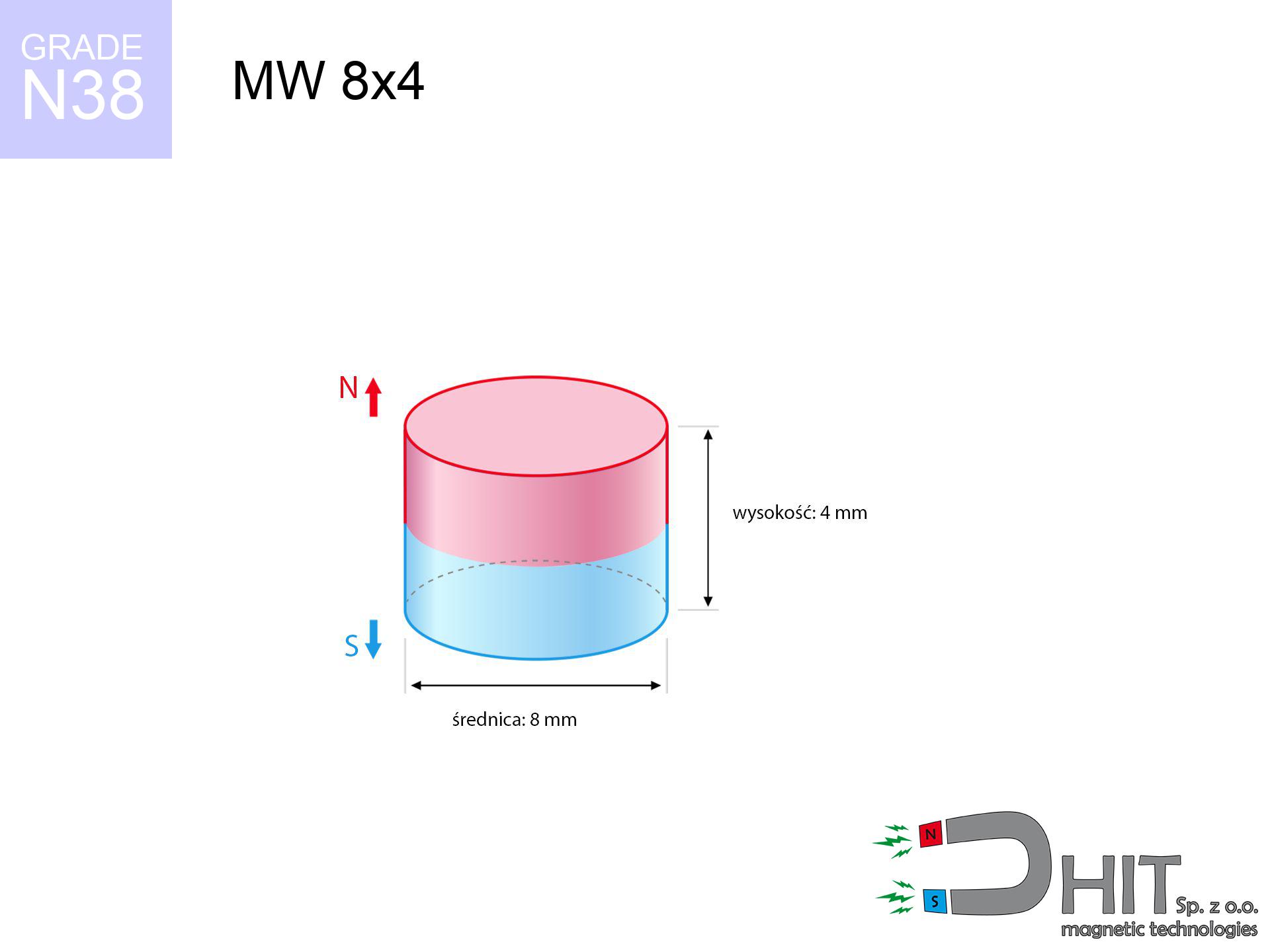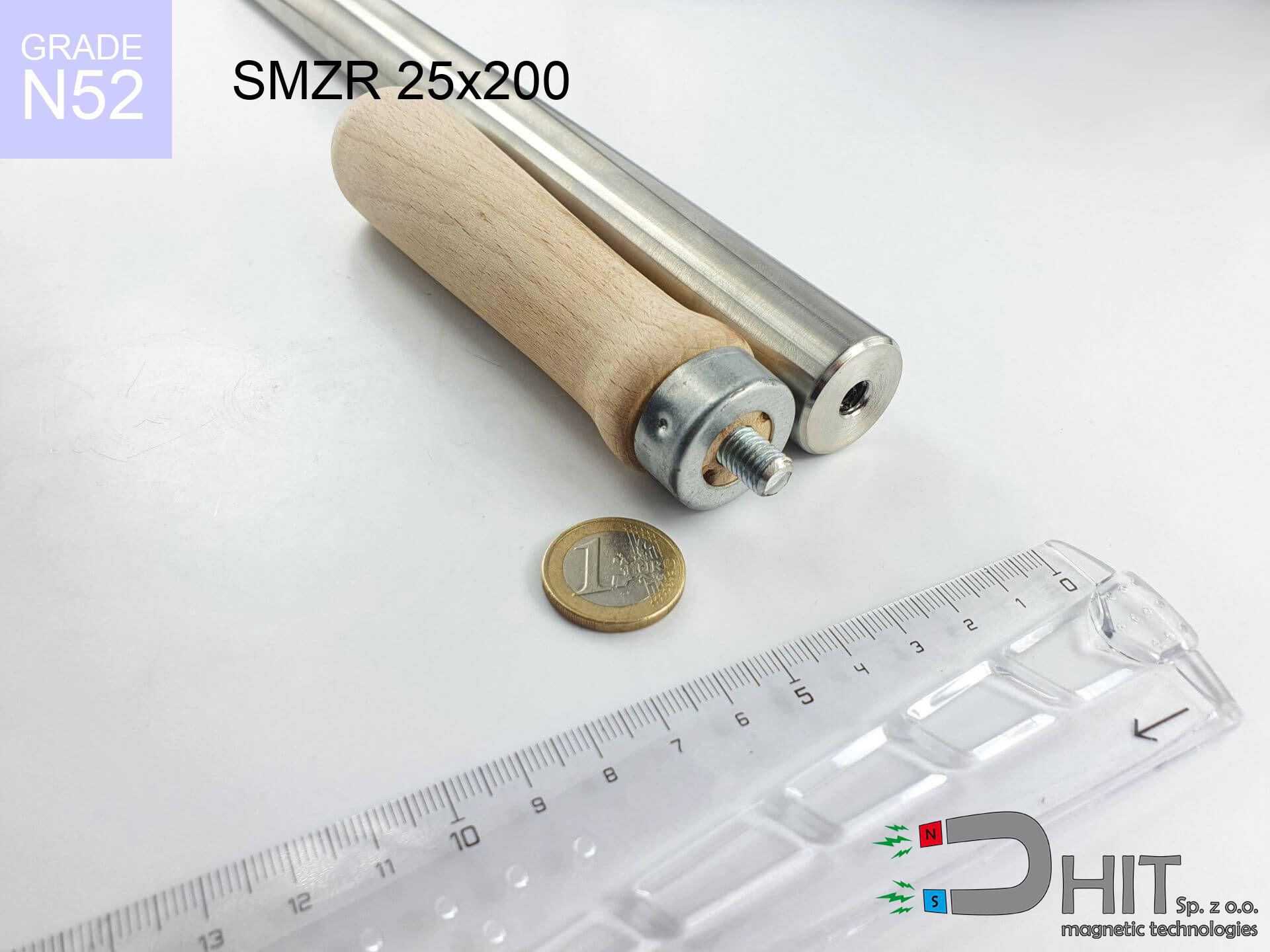MW 8x4 / N38 - cylindrical magnet
cylindrical magnet
Catalog no 010104
GTIN: 5906301811039
Diameter Ø [±0,1 mm]
8 mm
Height [±0,1 mm]
4 mm
Weight
1.51 g
Magnetization Direction
↑ axial
Load capacity
1.77 kg / 17.36 N
Magnetic Induction
437.78 mT
Coating
[NiCuNi] nickel
0.701 ZŁ with VAT / pcs + price for transport
0.570 ZŁ net + 23% VAT / pcs
bulk discounts:
Need more?Hunting for a discount?
Call us now
+48 888 99 98 98
if you prefer get in touch via
form
our website.
Lifting power as well as form of a magnet can be analyzed with our
force calculator.
Orders placed before 14:00 will be shipped the same business day.
MW 8x4 / N38 - cylindrical magnet
Magnetic properties of material N38
Physical properties of NdFeB
Shopping tips
Moreover, although neodymium is part of the strongest magnets, they are prone to corrosion in humid environments. Therefore, they are coated with a thin layer of silver to protect them from corrosion. It's worth noting that NdFeB neodymium magnets are about 13% lighter than SmCo magnets and, despite their power, are brittle, which requires special caution during their handling. Therefore, any mechanical processing should be done before they are magnetized.
In terms of safety, there are many recommendations regarding the use of these magnets. They should not be used in acidic, basic, organic environments or where solvents are present, and also in water or oil. Additionally, they can distort data on magnetic cards and hard drives, although data deletion using a neodymium magnet is not guaranteed.
In terms of properties in different environments, neodymium magnets are sensitive to corrosion, especially in humid conditions. Therefore, they are often coated with thin coatings, such as nickel, to shield them from external factors and prolong their durability. Temperatures exceeding 130°C can result in a loss of their magnetic strength, although there are specific types of neodymium magnets that can tolerate temperatures up to 230°C.
As for risks, it is important to avoid using neodymium magnets in acidic conditions, basic environments, organic or solvent environments, unless they are adequately insulated. Additionally, their use is not recommended in wet conditions, oil, or in an atmosphere containing hydrogen, as they may lose their magnetic properties.
Advantages and disadvantages of neodymium magnets NdFeB.
Apart from their strong holding force, neodymium magnets have these key benefits:
- They do not lose their power around 10 years – the reduction of power is only ~1% (based on measurements),
- They show strong resistance to demagnetization from external magnetic fields,
- By applying a reflective layer of gold, the element gains a clean look,
- They exhibit extremely high levels of magnetic induction near the outer area of the magnet,
- These magnets tolerate elevated temperatures, often exceeding 230°C, when properly designed (in relation to form),
- Thanks to the possibility in shaping and the capability to adapt to specific requirements, neodymium magnets can be created in diverse shapes and sizes, which broadens their application range,
- Significant impact in new technology industries – they are used in computer drives, electric drives, healthcare devices along with other advanced devices,
- Compactness – despite their small size, they generate strong force, making them ideal for precision applications
Disadvantages of rare earth magnets:
- They are prone to breaking when subjected to a powerful impact. If the magnets are exposed to shocks, we recommend in a steel housing. The steel housing, in the form of a holder, protects the magnet from breakage , and at the same time strengthens its overall resistance,
- Magnets lose magnetic efficiency when exposed to temperatures exceeding 80°C. In most cases, this leads to irreversible performance loss (influenced by the magnet’s dimensions). To address this, we provide [AH] models with superior thermal resistance, able to operate even at 230°C or more,
- They rust in a humid environment, especially when used outside, we recommend using encapsulated magnets, such as those made of rubber,
- The use of a protective casing or external holder is recommended, since machining fine details in neodymium magnets is not feasible,
- Safety concern related to magnet particles may arise, if ingested accidentally, which is significant in the context of child safety. Additionally, minuscule fragments from these assemblies have the potential to disrupt scanning if inside the body,
- Due to expensive raw materials, their cost is above average,
Highest magnetic holding force – what it depends on?
The given lifting capacity of the magnet represents the maximum lifting force, determined in ideal conditions, namely:
- with the use of low-carbon steel plate acting as a magnetic yoke
- having a thickness of no less than 10 millimeters
- with a polished side
- with no separation
- with vertical force applied
- under standard ambient temperature
Key elements affecting lifting force
In practice, the holding capacity of a magnet is conditioned by these factors, arranged from the most important to the least relevant:
- Air gap between the magnet and the plate, because even a very small distance (e.g. 0.5 mm) causes a drop in lifting force of up to 50%.
- Direction of applied force, because the maximum lifting capacity is achieved under perpendicular application. The force required to slide the magnet along the plate is usually several times lower.
- Thickness of the plate, as a plate that is too thin causes part of the magnetic flux not to be used and to remain wasted in the air.
- Material of the plate, because higher carbon content lowers holding force, while higher iron content increases it. The best choice is steel with high magnetic permeability and high saturation induction.
- Surface of the plate, because the more smooth and polished it is, the better the contact and consequently the greater the magnetic saturation.
- Operating temperature, since all permanent magnets have a negative temperature coefficient. This means that at high temperatures they are weaker, while at sub-zero temperatures they become slightly stronger.
* Lifting capacity was measured using a polished steel plate of suitable thickness (min. 20 mm), under perpendicular pulling force, whereas under parallel forces the load capacity is reduced by as much as 5 times. In addition, even a slight gap {between} the magnet and the plate decreases the holding force.
Exercise Caution with Neodymium Magnets
Neodymium Magnets can attract to each other, pinch the skin, and cause significant injuries.
Magnets will jump and clash together within a distance of several to around 10 cm from each other.
Neodymium magnets can demagnetize at high temperatures.
Although magnets have demonstrated their effectiveness up to 80°C or 175°F, the temperature can vary depending on the type, shape, and intended use of the specific magnet.
Do not give neodymium magnets to children.
Neodymium magnets are not toys. Do not allow children to play with them. They can be a significant choking hazard. If multiple magnets are swallowed, they can attract to each other through the intestinal walls, causing significant injuries, and even death.
Never bring neodymium magnets close to a phone and GPS.
Magnetic fields can interfere with compasses and magnetometers used in aviation and maritime navigation, as well as internal compasses of smartphones and GPS devices. There are neodymium magnets in every smartphone, for example, in the microphone and speakers.
Dust and powder from neodymium magnets are flammable.
Do not attempt to drill into neodymium magnets. Mechanical processing is also not recommended. If the magnet is crushed into fine powder or dust, it becomes highly flammable.
The magnet coating contains nickel, so be cautious if you have a nickel allergy.
Studies clearly indicate a small percentage of people who suffer from metal allergies such as nickel. An allergic reaction often manifests as skin redness and rash. If you have a nickel allergy, try wearing gloves or avoid direct contact with nickel-plated neodymium magnets.
Neodymium magnets are the most powerful magnets ever invented. Their strength can surprise you.
Please review the information on how to handle neodymium magnets and avoid significant harm to your body, as well as prevent unintentional damage to the magnets.
Neodymium magnets should not be near people with pacemakers.
Neodymium magnets produce strong magnetic fields that can interfere with the operation of a heart pacemaker. Even if the magnetic field does not affect the device, it can damage its components or deactivate the entire device.
Make sure not to bring neodymium magnets close to the TV, wallet, and computer HDD.
Strong magnetic fields emitted by neodymium magnets can destroy magnetic storage media such as floppy disks, credit cards, magnetic ID cards, cassette tapes, video tapes, or other devices. In addition, they can damage televisions, VCRs, computer monitors, and CRT displays. Avoid placing neodymium magnets in close proximity to electronic devices.
Neodymium magnets are characterized by their fragility, which can cause them to shatter.
Neodymium magnets are extremely fragile, and by joining them in an uncontrolled manner, they will crumble. Neodymium magnets are made of metal and coated with a shiny nickel, but they are not as durable as steel. At the moment of collision between the magnets, small metal fragments can be dispersed in different directions.
Caution!
So that know how powerful neodymium magnets are and why they are so dangerous, read the article - Dangerous very strong neodymium magnets.




![SM 25x325 [2xM8] / N42 - magnetic separator SM 25x325 [2xM8] / N42 - magnetic separator](https://cdn3.dhit.pl/graphics/products/sm-25x325-2xm8-man.jpg)




